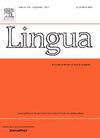Four types of passives in Japanese and their cross-linguistic implications
IF 1.3
3区 文学
0 LANGUAGE & LINGUISTICS
引用次数: 0
Abstract
This paper examines how the variety of so-called “passive constructions” can be viewed in terms of subject demotion and object promotion. I propose that four types of passives may logically exist due to possible combinations of the two independent operations: (i) both subject demotion and object promotion occur; (ii) only subject demotion occurs; (iii) only object promotion occurs; and (iv) neither subject demotion nor object promotion occurs but passive morphology is involved, demonstrating that they are all attested in Japanese. I argue that free Merge allows the Japanese passive morpheme (r)are to be externally merged with main V, little v, or [V-v] that is also created by External Merge, yielding V-(r)are, v-(r)are, and [V-v]-(r)are, respectively, with the result that the external θ-role is absorbed in V-(r)are, accusative Case is absorbed in v-(r)are, and both of them are absorbed in [V-v]-(r)are. I also show that (r)are can occur as a main verb, inducing neither subject demotion nor object promotion, but the passive sense may be expressed via assignment of an affectee θ-role to the surface subject. The analysis proposed here opens up new possibilities for unifying ways of generating the so-called non-canonical passives observed in various languages.
日语中的四种被动语态及其跨语言含义
本文探讨了如何从主语降格和宾语提升的角度来看待各种所谓的“被动结构”。我提出,由于两种独立操作的可能组合,在逻辑上可能存在四种类型的被动语态:(I)主语降格和客体提升同时发生;(ii)只发生降职;(iii)只发生对象提升;(4)既不发生主语降格,也不发生客体升格,但却涉及被动语态,说明它们在日语中都得到了证实。我认为自由归并允许日语被动语素(r)are在外部与主V、小V或由外部归并产生的[V- V]合并,分别产生V-(r)are、V-(r)are和[V- V]-(r)are,其结果是外部θ-作用被V-(r)are吸收,宾格被V-(r)are吸收,两者都被[V- V]-(r)are吸收。我还表明(r)are可以作为一个主要动词出现,既不引起主语的降格,也不引起宾语的提升,但是被动意义可以通过将受影响的θ-角色分配给表面主语来表达。这里提出的分析为在各种语言中观察到的所谓非规范被动语态的统一生成方式开辟了新的可能性。
本文章由计算机程序翻译,如有差异,请以英文原文为准。
求助全文
约1分钟内获得全文
求助全文
来源期刊

Lingua
Multiple-
CiteScore
2.50
自引率
9.10%
发文量
93
审稿时长
24 weeks
期刊介绍:
Lingua publishes papers of any length, if justified, as well as review articles surveying developments in the various fields of linguistics, and occasional discussions. A considerable number of pages in each issue are devoted to critical book reviews. Lingua also publishes Lingua Franca articles consisting of provocative exchanges expressing strong opinions on central topics in linguistics; The Decade In articles which are educational articles offering the nonspecialist linguist an overview of a given area of study; and Taking up the Gauntlet special issues composed of a set number of papers examining one set of data and exploring whose theory offers the most insight with a minimal set of assumptions and a maximum of arguments.
 求助内容:
求助内容: 应助结果提醒方式:
应助结果提醒方式:


